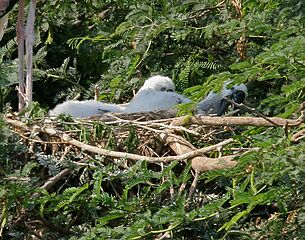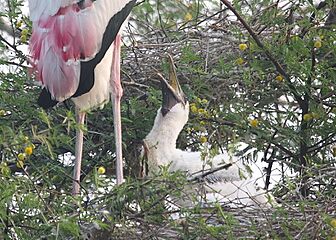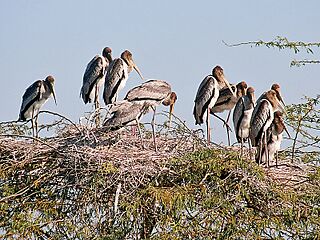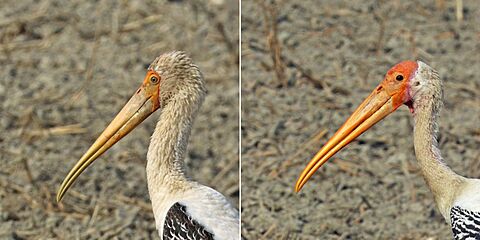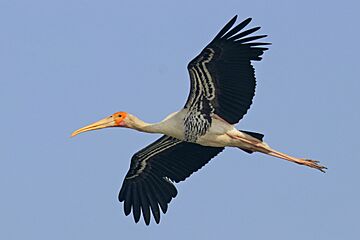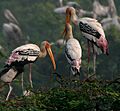Painted stork facts for kids
Quick facts for kids Painted stork |
|
|---|---|
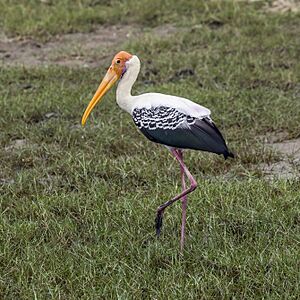 |
|
| Adult, Yala National Park, Sri Lanka | |
| Conservation status | |
| Scientific classification | |
| Genus: |
Mycteria
|
| Species: |
leucocephala
|
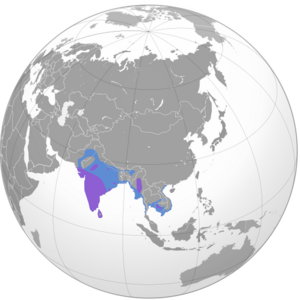 |
|
| Synonyms | |
|
Tantalus leucocephalus |
|
The painted stork (Mycteria leucocephala) is a large wader that belongs to the stork family. You can find these beautiful birds in the wetlands of tropical Asia, south of the Himalayas. This includes places like India and Southeast Asia.
Adult painted storks get their name from their special pink feathers on their wings. They often look for food in groups in shallow water, like along rivers or lakes. They hunt by putting their half-open beaks into the water and sweeping them from side to side. When they feel a small fish, they quickly snap it up! They also stir the water with their feet to make hidden fish move.
Painted storks build their nests together in trees, often with other waterbirds. They don't make many sounds, just soft moans or a clattering noise with their bills when they are at the nest. These storks don't travel far. They only move short distances if the weather changes, if they need more food, or when it's time to breed. Like other storks, they often fly high in the sky using warm air currents called thermals.
Contents
What Does a Painted Stork Look Like?
This big stork has a thick, yellow beak that curves downwards a bit, making it look a little like an ibis. The head of an adult stork has no feathers and is orange or reddish. Their long, special wing feathers are bright pink and cover their back when they are resting.
They also have a clear black band across their chest with white, scale-like patterns. This band continues under their wings, where white tips on black feathers make it look like they have white stripes. The rest of their body is mostly white. Their main flight feathers are black with a shiny green look.
Their legs are usually yellowish or red. But they often look white because storks sometimes poop on their legs to cool down! This is a special way they keep cool, especially when resting. Their short tail is black with a green shine.
Painted storks are medium-sized for a stork. They stand about 93 to 102 centimeters (36.5 to 40 inches) tall. Their wings can spread out about 150 to 160 centimeters (59 to 63 inches) wide. They weigh between 2 and 3.5 kilograms (4.4 to 7.7 pounds). Males and females look similar, but the male is usually a bit bigger.
Baby storks are mostly white and fluffy, with grey beaks and dark skin on their faces. Young storks have brownish feathers. Like most storks, they are ready to breed when they are two or three years old.
When they fly, storks keep their necks stretched out. They often use the warm air currents that rise in the late morning to soar. This helps them find places to feed. Storks are mostly quiet, but they do clatter their bills at the nest. They might also make some harsh croaking or soft moaning sounds when they are nesting.
-
Young storks in their nests on Prosopis juliflora trees in Bharatpur, India
Where Do Painted Storks Live?
Painted storks live across the plains of Asia. You can find them south of the Himalayan mountains. To the west, they are rare near the Indus River in Pakistan, but they spread east into Southeast Asia. They don't live in very dry places, deserts, thick forests, or high mountain areas.
They love freshwater wetlands all year round. But they also use irrigation canals and farm fields, especially flooded rice fields during the monsoon season. Most painted storks stay in one area, but they do move seasonally. Young birds might travel far from where they were born. For example, one young stork tagged in Keoladeo National Park was found 800 kilometers (500 miles) away in eastern India!
They always build their nests on large trees. These nesting trees are usually in safe places, like wetland reserves, village ponds, or even inside villages where people protect them. Some are found in zoos or on islands in city wetlands.
Painted Stork Behavior and Life Cycle
Painted storks feed in groups in shallow wetlands, farm fields, and canals. They are most successful at finding food in water about 7 centimeters (2.8 inches) deep. They mainly eat small fish. They find these fish by touch, slowly sweeping their half-open bill from side to side underwater. They walk slowly and also use their feet to stir the water, which makes fish move so they can catch them. They also eat frogs and sometimes even snakes.
They mostly look for food during the day. But sometimes, if conditions are unusual, they might feed late in the evening or even at night. After eating, they might stand still on the shore for a long time. Storks in some areas eat fish, while those in other places feed their babies frogs, crabs, large insects, and grasshoppers.
Groups of storks in farm areas are usually small (fewer than 5 birds). But in winter, after the young birds have left their nests, you can see flocks of over 50 birds.
Reproduction and Nesting
Painted storks build their nests in trees. They might nest in mixed groups with other water birds, or in colonies just by themselves. The breeding season starts in the winter months, soon after the monsoon rains. In northern India, they start nesting in mid-August. In southern India, they begin around October and continue until February or even April.
A female stork usually lays one to five eggs. Birds that start breeding earlier tend to lay more eggs. The eggs hatch after about one month. The young birds stay in the nest for almost two months before they can fly.
Sometimes, young storks in the nest are hunted by eagles, crows, and kites. During the hottest part of the day, adult storks stand at the nest with their wings spread out. This creates shade for their chicks to keep them cool. They also poop on their legs to cool down, especially when it's hot.
To feed their babies, adult storks bring back fish they have caught. These fish are usually smaller than 20 centimeters (8 inches) long. If young chicks feel threatened, they might spit out their food and pretend to be dead by collapsing in the nest. Baby storks need about 500 to 600 grams (1.1 to 1.3 pounds) of food each day, which is about 9 fish, fed in two sessions. Nests that start earlier in the monsoon season are more likely to succeed. Nests in larger colonies also do better.
The bare red skin on the adult stork's head appears when it's ready to breed. This happens as they lose feathers and get special fats under their skin. Storks living in zoos have been known to live for as long as 28 years. Baby storks raised by humans can become very friendly and calm, even responding when their names are called!
Protecting Painted Storks
Painted stork nesting colonies are often popular places for tourists to visit because the birds are so large and colorful. Some well-known nesting spots are in the villages of Kokrebellur and Veerapura in southern India. In Kokrebellur, the storks nest in trees right inside the village, often alongside spot-billed pelicans. The local people protect these birds during their nesting season, which lasts a few months from October.
Another famous colony has been studied since the 1960s at the Delhi Zoological Park in India. Here, 300 to 600 wild storks arrive about a month after the monsoon rains begin in Delhi. They use the trees on artificial islands inside the zoo.
The largest breeding group in northern India is found in Keoladeo-Ghana National Park, with an estimated 2,500 nests. Many other breeding colonies are known in southern India, including Uppalapadu village near Guntur, Kolleru, Gowtavaram Village, and Ranganathittu. Storks in zoos will also breed easily if they have nesting materials and platforms.
The largest healthy population of painted storks is in India. In Pakistan, storks along the Indus River are in danger because their chicks are sometimes taken for the bird trade. The species almost disappeared in Thailand, but small groups are still found in Cambodia and Vietnam. Some painted storks from Sri Lanka were released in Malaysia, and their population there is growing.
There are some worries about the painted stork mixing with the closely related milky stork, especially in zoos. This mixing has also happened in the wild in Cambodia and in several zoos. They have also mixed with lesser adjutant storks in some zoos, like in Sri Lanka, where a male painted stork and a female lesser adjutant had chicks together several times.
Images for kids



